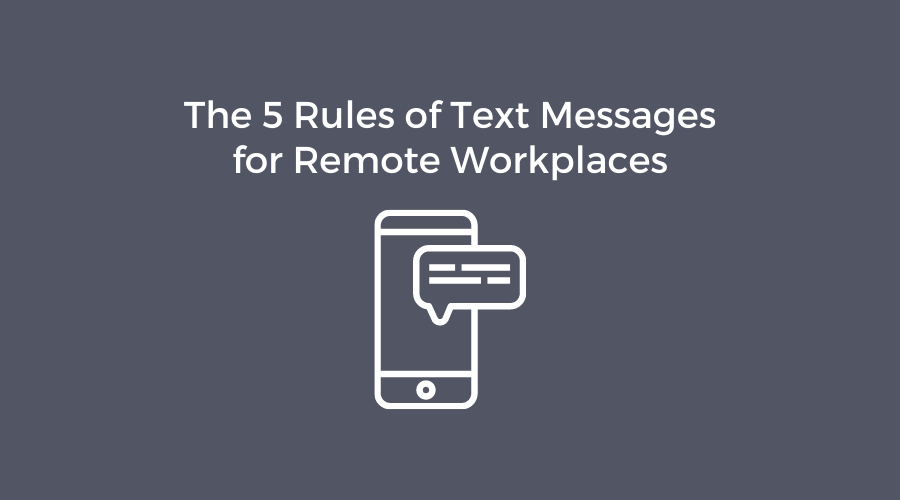
The 5 Rules of Text Messages for Remote Workplaces
As organizations look to foster a remote culture the communication tool stack is expanding. From staples like Slack and Zoom, companies are increasingly leveraging text messaging to complement existing solutions.
Text messaging has emerged as a crucial solution to fill the gaps left by conventional remote work apps – informal feedback, interview prep, team building and more. Consider the fact that employees spent on average about 56 minutes on their cell phones before the pandemic, and it quickly becomes clear why text messaging is one of the best ways to convey important, time-sensitive information.
However, in the era of back-to-back video calls and incessant IM pings, cognitive overload is becoming increasingly common. This risks important communication being swept under a pile of emails, chats, and messages.
So, what is the best way to use texting to cut through the clutter and maximize impact?
5 Golden Rules of Texting with Remote Employees
One of the reasons why text messages continue to remain the most effective communication tool is that they boast a 98% read rate. At a time when employee attention is elusive (read: digital overload), text messages offer a simple and inexpensive way for organizations to get important communication across.
To keep those numbers high, here are our five golden rules for communicating with remote employees via text:
1. Establish Communication Conventions
While most organizations have let the unsaid rules of digital communication dictate how employees use emails, IMs, and other collaboration software, texting must be handled with caution. Organizations need to clearly document how and when text messages are to be used. From the organizational/managerial side, text messages should only be used to convey certain types of information – policy updates (with a CTA to read the email), emergencies/alerts, HR updates, rewards and recognition, informal feedback, shift scheduling, expense and accounting, etc. While this is not an exhaustive list of use-cases for texting, you could use these pointers as guidelines to establish communication conventions.
2. Establish and Respect Boundaries
Work-life boundaries are hard to discern, particularly with a remote workforce. To succeed with text messages as a communication tool, organizations must recognize the fact that employee cell phone numbers are a private channel to their lives. Which means if you send out an SMS blast just when your employees are sitting down for dinner with their families, you are risking trust erosion.
Like most things culture, communication conventions also flow top down. Give your team uninterrupted time away from work. Resist the urge to send out SMS’ at odd hours to avoid making your employees feel like they need to be available around the clock.
Remember, healthy boundaries build trust.
3. Avoid Using Texts as a Substitute for Meetings
“That meeting could’ve been an email,” is one of the most common workplace sentiments today. However, in the age of remote work, face time is crucial. And overcommunication doesn’t hurt. Avoid using texts as an alternative to meetings. Need to provide feedback? Schedule a video call.
While text messages are incredibly effective, they fail to capture the nuances of in-person or face-to-face communication. As humans we’re subconsciously primed to decipher body language, tone, and expressions to fill in the missing bits of communication context.
Texting is not a proxy for human relationships at the workplace.
4. Language
Keep in mind that for most employees texting is reserved for family and friends, so, texting slang (c u l8r, ttyl, xoxo, etc.) can easily permeate into workplace messaging. It is important that you document the language rules for workplace texting with your employees. Basic best practices like re reading messages before sending should be communicated to all employees.
Texting slang could potentially become a compliance/legal nightmare for employers and leaders.
5. Send Consolidated Messages
Due to the informal nature of text messaging, many people approach it as spoken conversation in written form. While this practice is perfectly acceptable on IMs, it may deliver a broken and disjointed experience when used in SMS. A series of separate messages can be disorienting and annoying. [image_with_animation image_url=”9947″ animation=”Fade In” hover_animation=”none” alignment=”” border_radius=”none” box_shadow=”none” image_loading=”default” max_width=”100%” max_width_mobile=”default” img_link=”https://www.getapp.com/resources/business-chat-etiquette-rules-for-small-business/”]While the series of messages on the left will likely stress and distract the recipient, the single message on the right is much less likely to cause a disturbance.
Unlike IMs, text messages don’t have “typing…” status, so it is likely that the sender may get confused when receiving a string of messages.
Next Steps: Use the Right Tools to Perfect Your Text Game
The rules listed above can help you create a successful text messaging strategy, and help reduce distractions and digital burnout due to an “always on” remote work environment
But knowing what messaging solution meets your business needs is crucial.
Check out how Emissary can help. Schedule a demo to learn how to establish and succeed with your messaging strategy.


